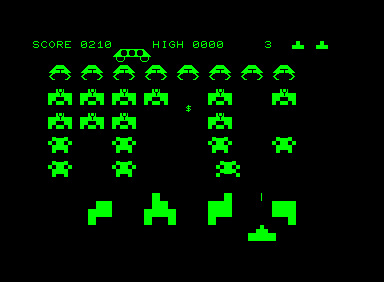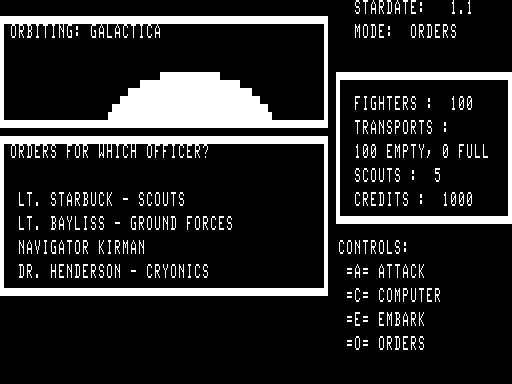Brief History of Computer Games: 1980
The rise of the TRS-80 and the Apple II
![]() By: E. Bolognesi
By: E. Bolognesi
Published: 15 September 2019, 5:19 pm
It's time to start talking about real games in this third chapter of the series.
The positive trend of computer gaming continued in 1980. It was a good year for the Commodore PET (the last one, to be honest), with 152 titles released, including the sequel to Dunjonquest and port of the famous arcade Space Invaders, written in BASIC. Despite the lack of bitmap graphics of the PET, the game is quite faithful to the original arcade, thanks to the excellent use of the PETSCII character set.

In 1979, Doug Carlston wrote a game called Galactic Empire on a 16KB TRS-80. It's the first of a series of four games that are considered the precursors to what would later be known as 4x games (eXplore, eXpand, eXploit, and eXterminate) – a term invented for Master of Orion. The game's success convinced Doug and his brother Gary to found a company in February 1980. They called it Brøderbund, and it would become one of the most prestigious publishers of the '80s. Galactic Empire, quickly ported also to the Apple II, was their first release.

With 222 games, the TRS-80 was the number one platform in terms of games released.
However, 1980 is the year in which the Apple II starts to become relevant. So relevant that a young couple working hard on their Apple II would change the history of video games. But before talking about them, we need to spend a few words on the tech specs of those computers.
The PET and the TRS-80 didn't have colors and could not display bitmap graphics, only text. It was possible to draw simple pictures using special characters containing lines, angles, dots, and more. It was possible thanks to an extension of the ASCII character set (called "PETSCII" on the PET), but this is far from "real" graphics.
Instead, the genius of Steve Wozniak blessed the Apple II, since the beginning, with 280x192 pixels bitmap graphics in monochrome or 140x192 pixels with four colors. This fact gave an immense advantage to the Apple II in terms of gaming. Unfortunately, the first version of Woz and Jobs' computer had other problems, for example, the lack of decimal numbers BASIC (not mentioning the very high price). But in 1979, the Apple II Plus was released, and this model was much more mature, with an impressive 48K of RAM, floating-point BASIC (called AppleSoft Basic), six colors (2 more than the original version), and a fast 5 1/4 floppy drive available as an expansion.

Knowing this, it should not surprise that the Apple II Plus became, almost immediately, the preferred platform of game developers.
One of them was Ken Williams, a young programmer that in 1980 with his wife Roberta, created the first-ever graphics adventure: Mystery House. Before them, adventure games had only text, so you can say that they really invented a new genre. But that's not all.
Because for the first time, someone had solved the problem of translating hand-made drawings into computer graphics. Roberta was the one drawing the images. But computers didn't have enough memory to store all the images pixel-by-pixel. The solution found by Ken was brilliant: instead of saving the final result, the game contained the set of instructions required to replicate the movements of Roberta's hand. You might call it vector graphics.

As you know, Ken and Roberta Williams founded one of the most prestigious companies in the games industry: Sierra On-Line (initially known as On-Line Systems). And, of course, they are the creators of the King's Quest series.
Another owner of an Apple II Plus was Richard "Lord British" Garriott. He wrote his first game, Akalabeth: World of Doom, in AppleSoft Basic. The game, an action RPG precursor of the Ultima series, was released in 1980. Initially, Garriott was creating the game using character graphics with a top-down view, similar to Dunjonquest. But then he decided to adopt a 3D first-person perspective for the dungeons, using the Apple II bitmap graphics.

It was the first time a computer role-playing game was using this kind of perspective. It's the same you will find later in Dungeon Master, Eye of the Beholder, Lands of Lore, and an infinite number of games.
But 1980 was also when Infocom finally released their famous Zork: The Great Underground Empire on microcomputers.
MIT students Dave Lebling, Marc Blank, and Tim Anderson created Zork on a mainframe, PDP-10, using a language called MDL. The development of Zork started in 1977, and they continued working on it, with the help of several contributors, until 1979. At this point, Zork had become a vast game with more than 190 rooms.
The success of the home computers convinced Anderson, Lebling, Blank, and other programmers to found a company called Infocom in 1979. Their first idea was to release Zork for the home computers. But the PDP-10 had a massive 1MB of memory and MDL that did not exist on home computers.
To port Zork to the TRS-80 and Apple II, they heavily reduced the size of the game and developed a new language called ZIL. This language was inspired by MDL but with only the features required to run adventure games. At that point, porting Zork to different computers was a matter of developing a ZIL interpreter (called "virtual machine") for the target platform. Not so easy, of course, but they just needed to do it once. Zork and every other game written in ZIL could run on any platform as long as the virtual machine was available.

In December 1980, Infocom released Zork for the TRS-80, and in February 1981, when the virtual machine was ready, for the Apple II. Many other versions will arrive in the following years.
Infocom was the only company not tied to a single platform and able to release its titles to several home computers simultaneously.
